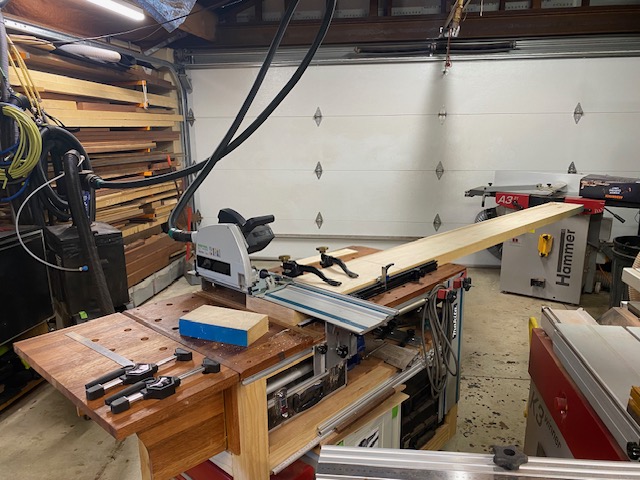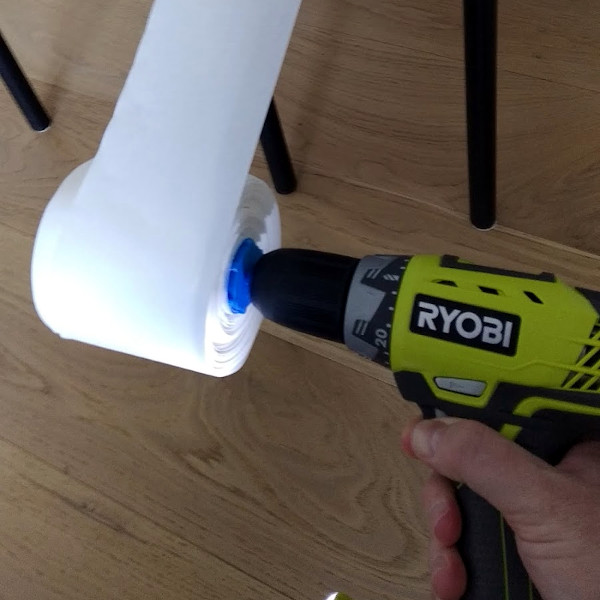derekcohen
Member
- Joined
- Jun 22, 2008
- Messages
- 1,019
Last weekend a friend came around for help in building a cabinet for a bathroom. The top is a 2" thick Jarrah slab with a live edge. Sawing the ends was a task for my tracksaw, and I set this up and made a few cuts. They were rough and really poor. I have never seen this before. The last time I used this tracksaw was about a month ago, and it produced clean and defined saw cuts. Also, as I recall, the kerf was narrower in the past. This suggested to me that either the blade was loose or damaged. I looked for these and could not find any evidence.
The tracksaw is a 20-year old Festool AT65E, which is in truly excellent condition. I purchased it about 18 months ago, and it looked like it had minimal use. The blade is almost new (one I replaced). Now I do recall cleaning the saw and taking a cut about a month ago, and the blade being slightly loose, and it rubbed against the chassis. I tightened it, used it, and all appeared well. That is the only possible "bump" I can think of.
I took the saw in to a Festool agent this week, explained the situation, and collected the saw yesterday. They said that they could not find any problems. I had questioned whether the arbor was loose or whether a bearing was worn, and they said there was no evidence of either. Today I took some cuts, and the problem was still there. Here are the cuts in Jarrah and some other hardwood ...


The interesting thing is that the cuts are clean at the offcut side ...

I do have another blade, brand new and unused, which came with the saw. This is cheapish and thin-kerf, but the same size and number of teeth. Here are the cuts (burning evident) ...

Here is the saw blade ...

Close up of the size ...

There is the track itself. This is a Makita, but the fit is good, all appears straight and clean, and unlikely to be affecting the result.
Finally, there is no play in any part of the saw bracket.
I keep coming back to a bearing (but there is no unusual noise) or play in the arbor - I can feel a minute but of play with the blade off, but not with it on - if there was play, how much is needed to cause such a rough cut, and why only on one side of (both) blades and not the other?
Okay friends, what are your diagnoses and recommendations?
Regards from Perth
Derek
The tracksaw is a 20-year old Festool AT65E, which is in truly excellent condition. I purchased it about 18 months ago, and it looked like it had minimal use. The blade is almost new (one I replaced). Now I do recall cleaning the saw and taking a cut about a month ago, and the blade being slightly loose, and it rubbed against the chassis. I tightened it, used it, and all appeared well. That is the only possible "bump" I can think of.
I took the saw in to a Festool agent this week, explained the situation, and collected the saw yesterday. They said that they could not find any problems. I had questioned whether the arbor was loose or whether a bearing was worn, and they said there was no evidence of either. Today I took some cuts, and the problem was still there. Here are the cuts in Jarrah and some other hardwood ...


The interesting thing is that the cuts are clean at the offcut side ...

I do have another blade, brand new and unused, which came with the saw. This is cheapish and thin-kerf, but the same size and number of teeth. Here are the cuts (burning evident) ...

Here is the saw blade ...

Close up of the size ...

There is the track itself. This is a Makita, but the fit is good, all appears straight and clean, and unlikely to be affecting the result.
Finally, there is no play in any part of the saw bracket.
I keep coming back to a bearing (but there is no unusual noise) or play in the arbor - I can feel a minute but of play with the blade off, but not with it on - if there was play, how much is needed to cause such a rough cut, and why only on one side of (both) blades and not the other?
Okay friends, what are your diagnoses and recommendations?
Regards from Perth
Derek






